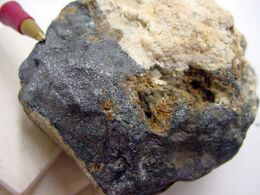Chemistry:Bismite
From HandWiki
Short description: Bismuth trioxide, or Bi2O3
| Bismite | |
|---|---|
 Bismite | |
| General | |
| Category | Oxide minerals |
| Formula (repeating unit) | Bi2O3 |
| Strunz classification | 4.CB.60 |
| Crystal system | Monoclinic |
| Crystal class | Prismatic (2/m) (same H-M symbol) |
| Space group | P21/c |
| Identification | |
| Color | Grey |
| Fracture | Uneven |
| Streak | Grey to black |
| References | [1] |
Bismite is a bismuth oxide mineral, bismuth trioxide or Bi2O3. It is a monoclinic mineral, but the typical form of occurrence is massive and clay-like with no macroscopic crystals. The color varies from green to yellow. It has a Mohs hardness of 4 to 5 and a specific gravity of 8.5 to 9.5, quite high for a nonmetallic mineral.
Bismite is a secondary oxidation zone mineral which forms from primary bismuth minerals.
It was first described from Goldfield, Nevada in 1868, and later from the Schneeberg District, Ore Mountains, Saxony, Germany .
See also
- Bismuth trioxide – details on the chemistry of this substance
References
- ↑ Mineralienatlas
- ↑ Warr, L.N. (2021). "IMA–CNMNC approved mineral symbols". Mineralogical Magazine 85 (3): 291–320. doi:10.1180/mgm.2021.43. Bibcode: 2021MinM...85..291W.
 |

